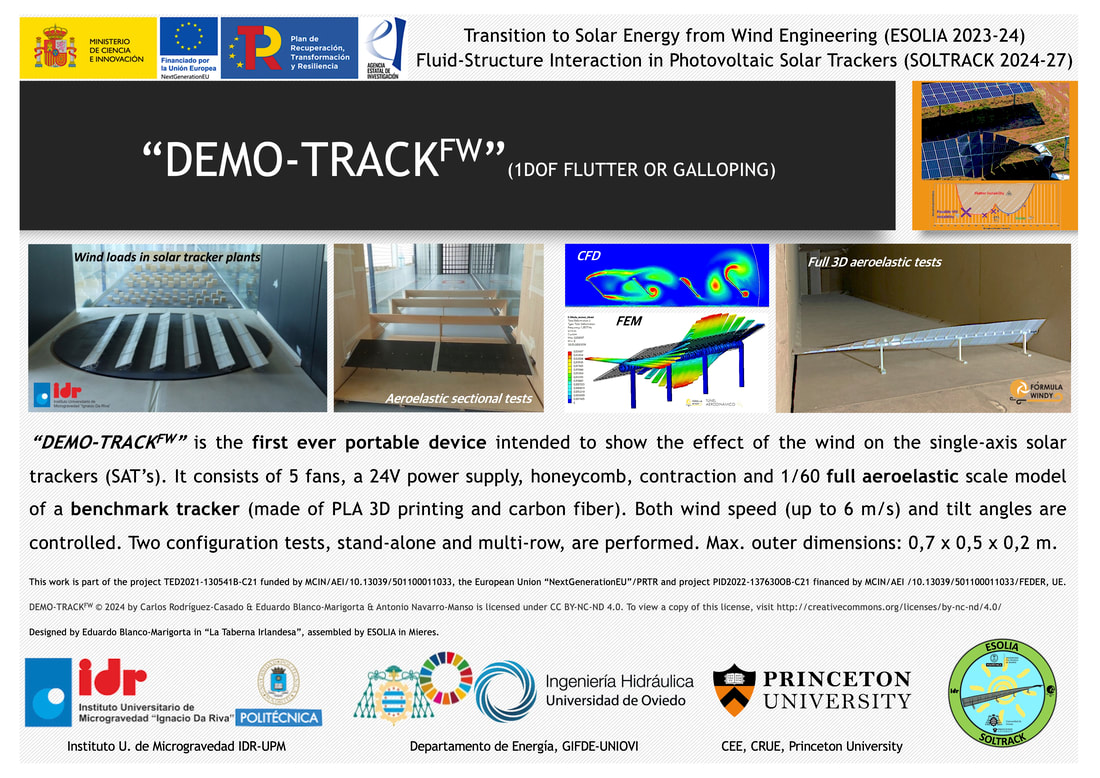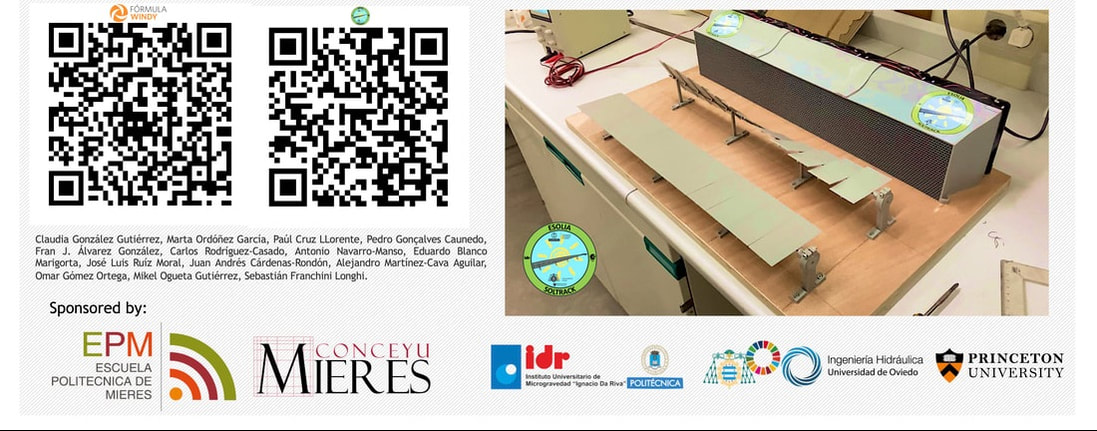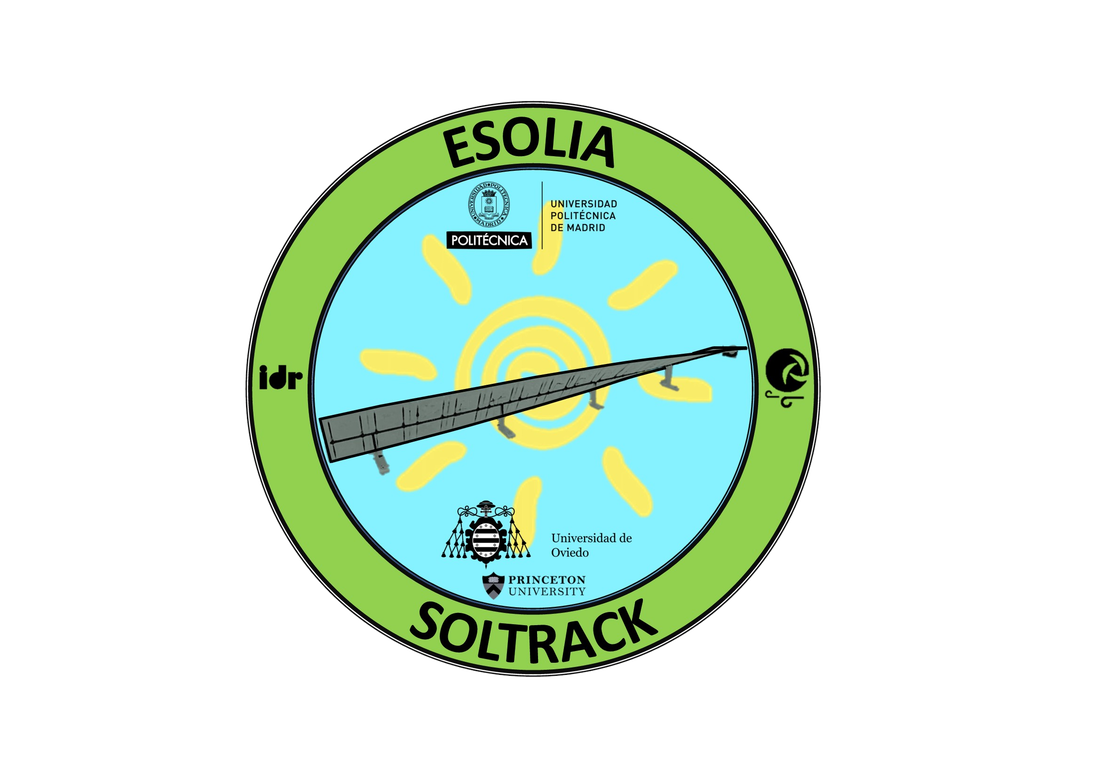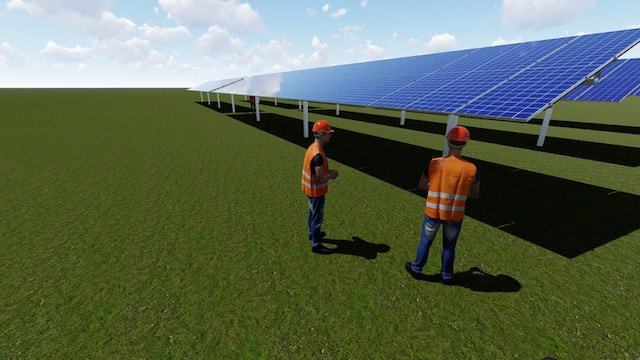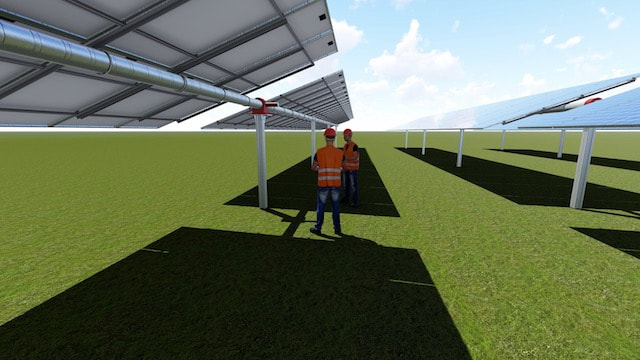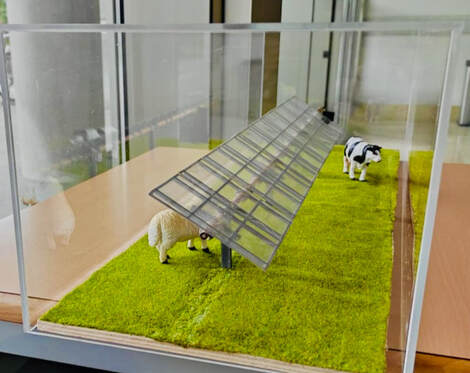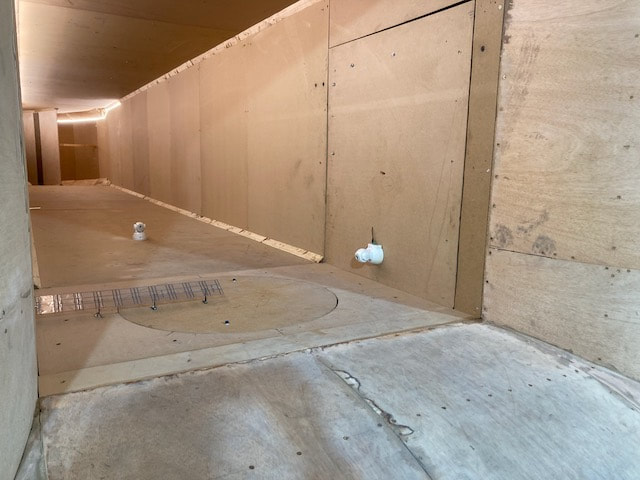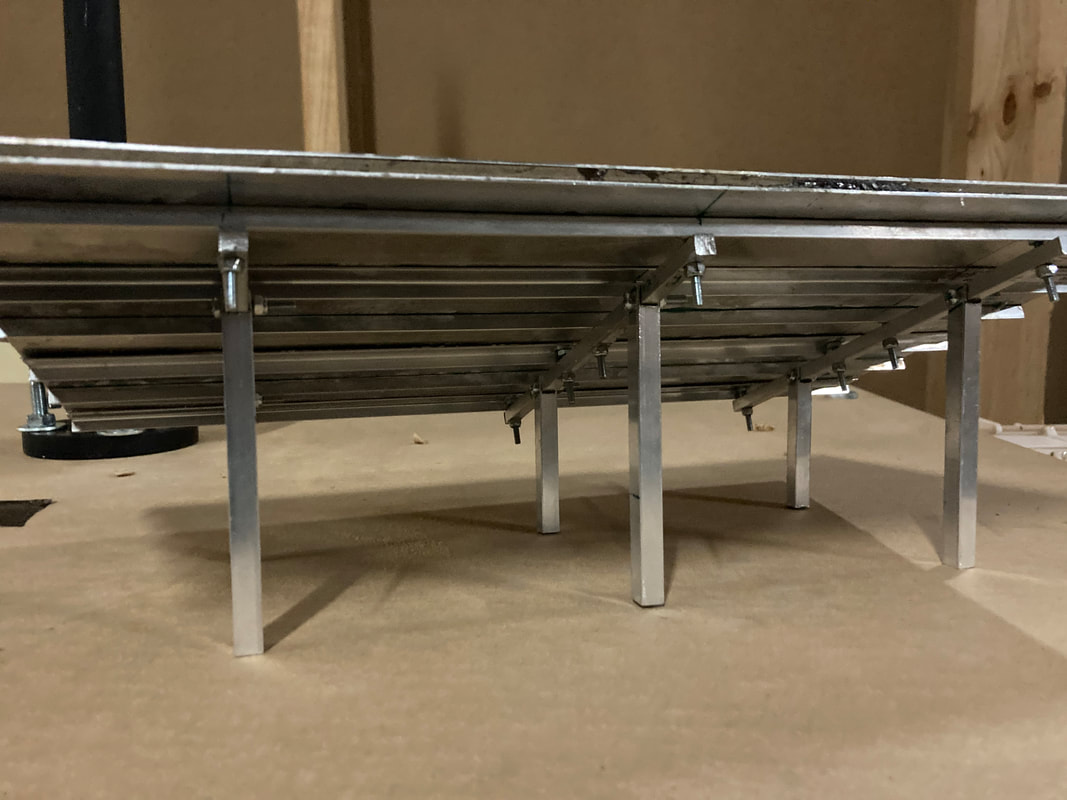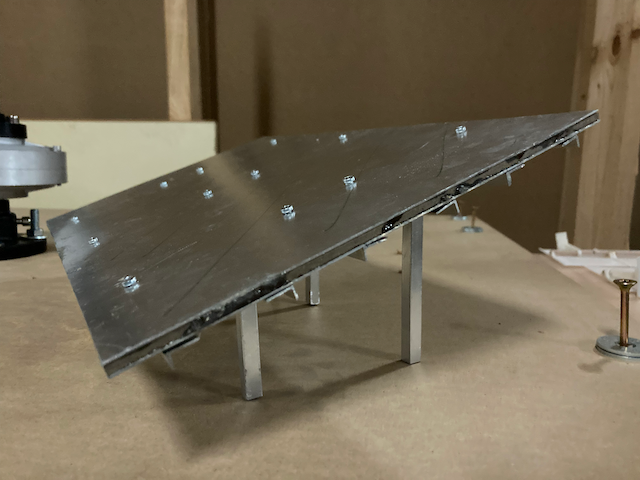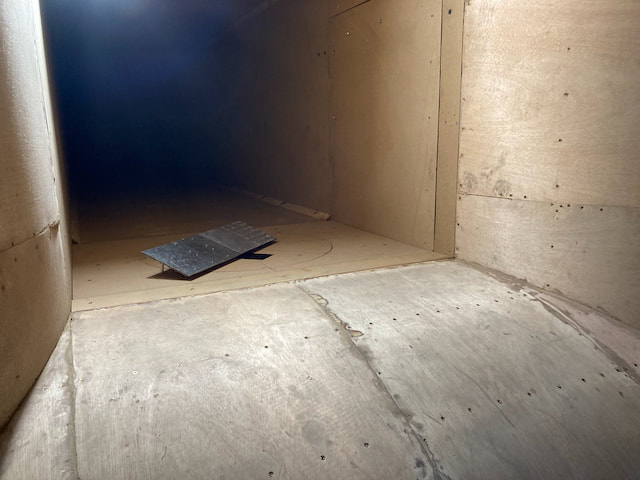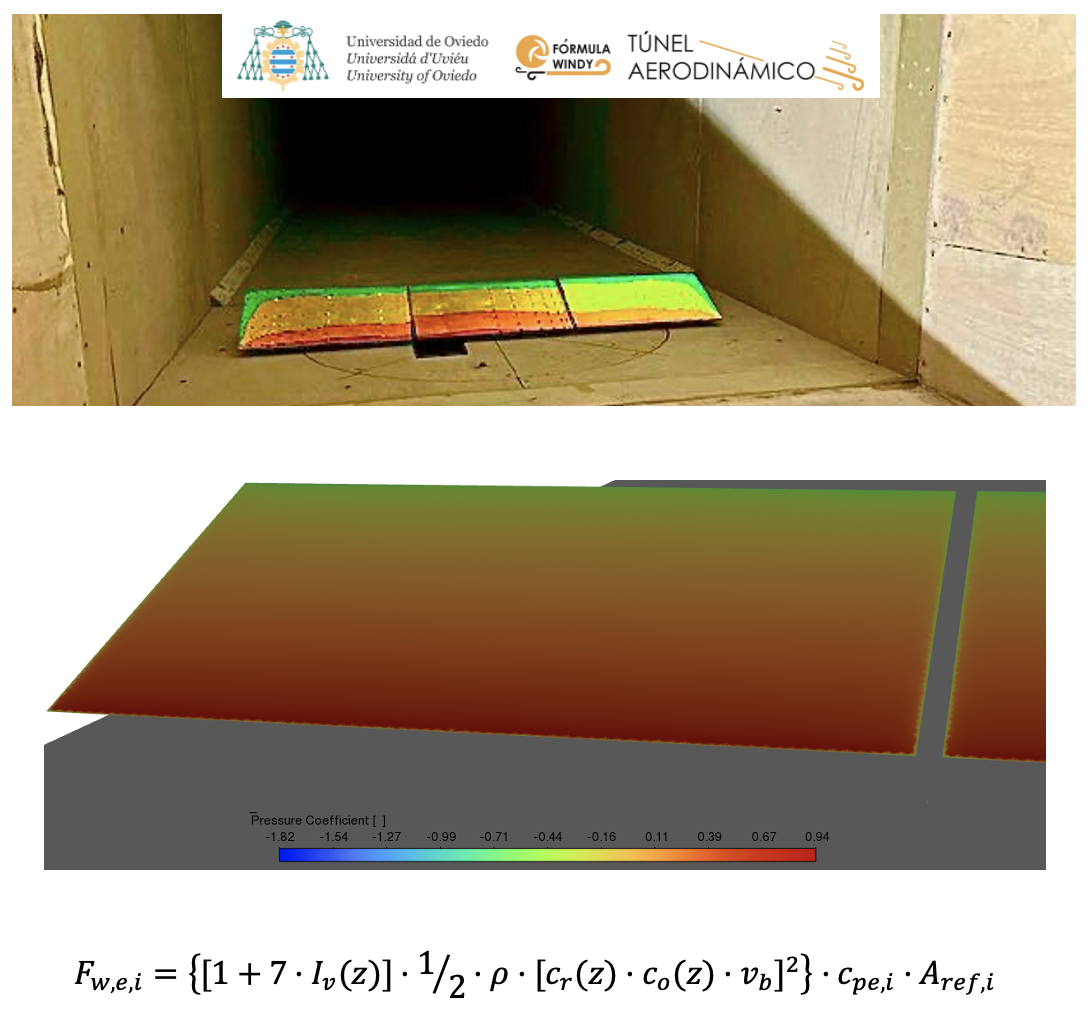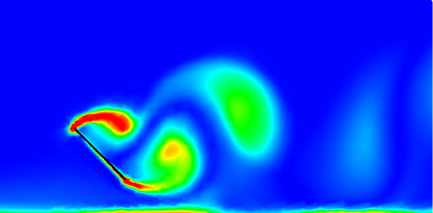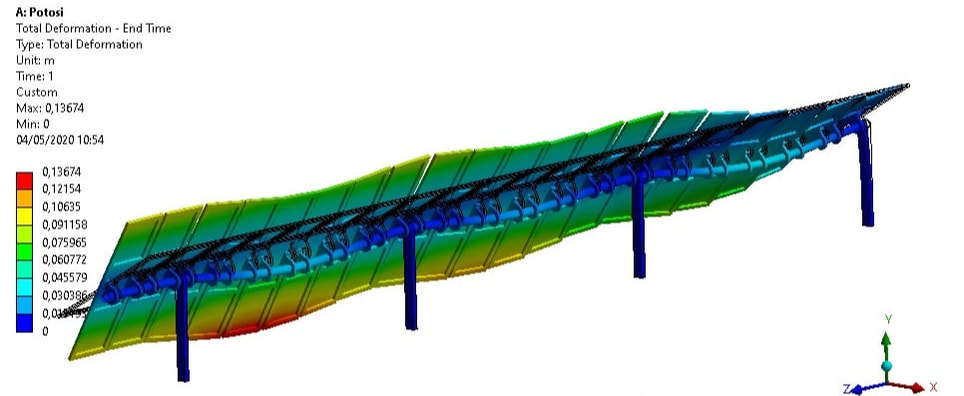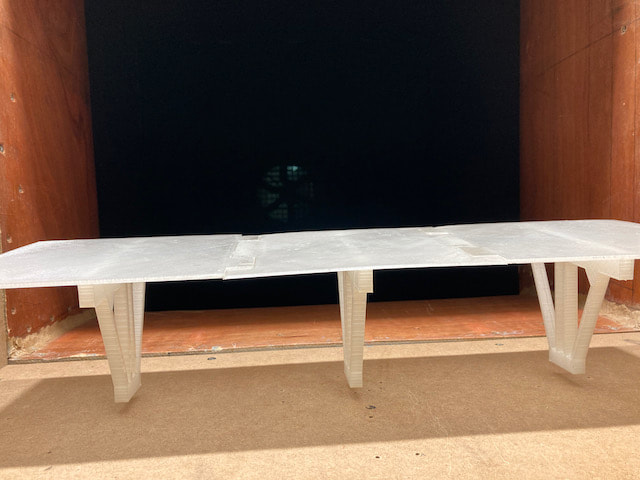related projects: Research, Academic and Companies
DEMO-TRACKF_W.
Fluid-structure interaction in photovoltaic solar trackers (SOLTRACK=WT UPM-idr+CFD Uniovi-GIFDE), National Plan.
Transition to solar energy from wind engineering (ESOLIA=SOLTAE UPM-idr+DESPWIND Uniovi-GIFD), National Plan.
Study of the structure for a photovoltaic power plant, Spain. (Appplus-Norcontrol, Iberdrola).
White Paper: "Diagrama de estabilidad del tracker: como diseñar frente a los efectos aeroelásticos".
Ultimate & Resilient solar tracker generation (TSK).
Aeroelastic analysis of single axis Photovoltaic Solar Trackers.
Aerodynamics of solar panels (ground fixed, ballasted, carports, etc.) (Praxia Energy, S.L.)
Influence of ground proximity to a tilt flat plate. I: static coeffs.
Click the accordion to see the projects, then scroll down. Use the arrow button to go back to the top.

This work is licensed under a Creative Commons Attribution-NonCommercial-NoDerivatives 4.0 International License.
DEMO-TRACK_FW
“DEMO-TRACK_FW” is the first ever portable device intended to show the effect of the wind on the single-axis solar trackers (SAT’s), by ESOLIA&SOLTRACK Team and sponsored by "Excmo. Ayuntamiento de Mieres", the Polytechnic School of Mieres and IMEnergy Power Plants S. L. It is intended to be a reference tool not only for research on the aeroelastic instabilities of single axis solar trackers but also for teaching & learning of Wind Engineering.
FLUID-STRUCTURE INTERACTION IN PHOTOVOLTAIC TRACKERS (SOLTRACK), FT. idr-UPM (2024-2027).
The Joint Venture by UPM-idr and Uniovi-GIFD has been once again awarded with a Research Project on behalf of the "Ministerio de Ciencia e Innovación, Proyectos de Generación del Conocimiento". Princeton University maintain its collaboration with our University. Works will begin in December 2023 and they will span four years.
Coordinated Project: Fluid-structure interaction in photovoltaic trackers (SOLTRACK).
Subp. 1: Wind tunnel investigation of the fluid-structure interaction in photovoltaic solar trackers (WT-SOLTRACK).
Subp. 2: Numerical investigation of the fluid-structure interaction in photovoltaic solar trackers (CFD-SOLTRACK).
(Ref. PID2022-137630OB-C22).
Coordinated Project: Fluid-structure interaction in photovoltaic trackers (SOLTRACK).
Subp. 1: Wind tunnel investigation of the fluid-structure interaction in photovoltaic solar trackers (WT-SOLTRACK).
Subp. 2: Numerical investigation of the fluid-structure interaction in photovoltaic solar trackers (CFD-SOLTRACK).
(Ref. PID2022-137630OB-C22).
SUMMARY.
Solar energy is currently, in Spain, the 4th most important source of electricity production, with 10% of installed electrical power. Nowadays, utility-scale solar installations have one of the lowest levelized cost of electricity production (LCOE) in the renewable energy sector, thanks to solar trackers with a single degree of freedom.
The limit that now blocks the progress of this technology and restricts the expected cost reductions is the occurrence of systematic tracker breakage due to aeroelastic effects. This problem is not yet solved, neither with respect to the calculation methodology, nor even with respect to the number or nature of the instabilities that may occur.
The most frequently cited are torsional divergence, vibrations induced by vortex shedding, buffeting and torsional flutter (with one degree of freedom).
This project aims to increase the knowledge of the aeroelastic problem presented by these structures, especially from the point of view of fluid-structure interaction. The purpose is to understand how the unsteady flow is formed and developed, leading to the onset and maintenance of these instabilities, especially the flutter, which, according to what has been observed, responds to a limit cycle. Being a dynamic instability determined by a complex interaction, in order to fully understand the phenomenon it is necessary to have abundant high quality information on the flow and pressure distributions that generate the loads on the photovoltaic solar trackers. For this purpose, a coordinated project is proposed, involving, on the one hand, a series of experimental campaigns in wind tunnels and, on the other hand, a set of numerical analyses (CFD). Both techniques are complementary and collaborate to achieve a deep understanding of the complex dynamic phenomena to be investigated.
Specifically, in the section corresponding to this subproject, the following objectives are to be achieved:
- To build a series of numerical models or digital twins, both of the scale models used in the wind tunnel and of the real FSS (prototype).
- To develop the necessary procedures and calculation systems to be able to simulate the fluid-structure interaction specific to these phenomena.
- To compare and validate, with the experimental data from the other subproject, the numerical simulation tools for the study of dynamic aeroelastic instabilities.
- To use the numerical models developed to increase the knowledge about the flow around the SSF under flutter conditions and how this is related to the generation of the loads that give rise to this instability.
- To create a series of standard models to facilitate the transfer of the techniques and knowledge acquired both to the industry and to other research centers.
The global knowledge of the aeroelastic behavior sought in this Project will allow the optimization of the design of the solar parks, achieving a reduction in their construction and operation cost and, therefore, a reduction in the energy price they produce. It is thus aligned with the R+D+I priorities established in the PEICTI 2021-2023 for the thematic area: 5. Energy and Climate.
Experience and contributions of the PIs of the projects ESOLIA + SOLTRACK.
Sebastián Franchini Longhi is Full Professor at the ETSI Aeronautics and Space and researcher at the University Institute "Ignacio Da Riva" of the UPM (IDR/UPM). His research career is characterized by an applied research activity, developed in Aerodynamics and Aeroelasticity. He has participated in 15 research projects funded in competitive calls, being PI in three of them. He is co-author of 33 articles in JCR journals and 51 international conferences. He has supervised 10 doctoral theses and is coordinator of the Applied Aerodynamics Group of the IDR/UPM. He has participated or directed research and consulting projects for companies in relation to Civil Aerodynamics and Wind Energy applications, including more than 100 wind tunnel tests.
Mikel Ogueta Gutiérrez is Associate Professor at the ETSI Aeronautics and Space of the UPM since 2021. In addition to having participated in a project funded by a competitive public call, he has worked in more than 70 projects with companies in the construction and engineering sector, performing wind tunnel tests of elements such as roofs, facades, bridges or projects related to renewable energies (solar and wind energy). He is co-author of 10 articles in JCR journals (6 of them Q1) and 25 international congresses and has co-directed 1 PhD thesis. Since 2019 he is secretary of the Spanish section of IAWE.
Antonio Navarro Manso holds a Ph.D. in "Ingeniería de Caminos, Canales y Puertos" (specialty: Structures) and a Master in Civil Engineering Research from the University of Cantabria. He is currently Associate Professor of Hydraulic Engineering at the University of Oviedo. Prior to his university career, he has developed an intense professional work as Head of Technical Office and Production Manager of several civil works, especially in the Cantabrian Highway, Spain. Regarding his research, he has published 16 articles in JCR journals, 4 books and participated in 25 International Conferences. He has conducted 52 research projects and contracts (18 P.I.) and is the holder of 2 patents. He has been in charge of the construction of the Atmospheric Boundary Layer Wind Tunnel at the University of Oviedo (currently CEO) and the wind tunnel for the Department of Civil and Environmental Engineering at Princeton University.
Eduardo Blanco Marigorta is Full Professor of Fluid Mechanics in the Department of Energy at the University of Oviedo. He has a long research career in Fluid Dynamics, both experimental and numerical, and in renewable energies. He is the author of more than 70 articles in JCR journals and 48 international conferences. He has participated in 35 competitive projects (2 strategic singular) and about 40 contracts with companies. He has also supervised 10 doctoral theses, is Coordinator of the Fluid Dynamic Engineering Group of the University of Oviedo (GIFD) and is responsible for the development, management and administration of the Scientific Computing Cluster of the Fluid Mechanics Area.
Solar energy is currently, in Spain, the 4th most important source of electricity production, with 10% of installed electrical power. Nowadays, utility-scale solar installations have one of the lowest levelized cost of electricity production (LCOE) in the renewable energy sector, thanks to solar trackers with a single degree of freedom.
The limit that now blocks the progress of this technology and restricts the expected cost reductions is the occurrence of systematic tracker breakage due to aeroelastic effects. This problem is not yet solved, neither with respect to the calculation methodology, nor even with respect to the number or nature of the instabilities that may occur.
The most frequently cited are torsional divergence, vibrations induced by vortex shedding, buffeting and torsional flutter (with one degree of freedom).
This project aims to increase the knowledge of the aeroelastic problem presented by these structures, especially from the point of view of fluid-structure interaction. The purpose is to understand how the unsteady flow is formed and developed, leading to the onset and maintenance of these instabilities, especially the flutter, which, according to what has been observed, responds to a limit cycle. Being a dynamic instability determined by a complex interaction, in order to fully understand the phenomenon it is necessary to have abundant high quality information on the flow and pressure distributions that generate the loads on the photovoltaic solar trackers. For this purpose, a coordinated project is proposed, involving, on the one hand, a series of experimental campaigns in wind tunnels and, on the other hand, a set of numerical analyses (CFD). Both techniques are complementary and collaborate to achieve a deep understanding of the complex dynamic phenomena to be investigated.
Specifically, in the section corresponding to this subproject, the following objectives are to be achieved:
- To build a series of numerical models or digital twins, both of the scale models used in the wind tunnel and of the real FSS (prototype).
- To develop the necessary procedures and calculation systems to be able to simulate the fluid-structure interaction specific to these phenomena.
- To compare and validate, with the experimental data from the other subproject, the numerical simulation tools for the study of dynamic aeroelastic instabilities.
- To use the numerical models developed to increase the knowledge about the flow around the SSF under flutter conditions and how this is related to the generation of the loads that give rise to this instability.
- To create a series of standard models to facilitate the transfer of the techniques and knowledge acquired both to the industry and to other research centers.
The global knowledge of the aeroelastic behavior sought in this Project will allow the optimization of the design of the solar parks, achieving a reduction in their construction and operation cost and, therefore, a reduction in the energy price they produce. It is thus aligned with the R+D+I priorities established in the PEICTI 2021-2023 for the thematic area: 5. Energy and Climate.
Experience and contributions of the PIs of the projects ESOLIA + SOLTRACK.
Sebastián Franchini Longhi is Full Professor at the ETSI Aeronautics and Space and researcher at the University Institute "Ignacio Da Riva" of the UPM (IDR/UPM). His research career is characterized by an applied research activity, developed in Aerodynamics and Aeroelasticity. He has participated in 15 research projects funded in competitive calls, being PI in three of them. He is co-author of 33 articles in JCR journals and 51 international conferences. He has supervised 10 doctoral theses and is coordinator of the Applied Aerodynamics Group of the IDR/UPM. He has participated or directed research and consulting projects for companies in relation to Civil Aerodynamics and Wind Energy applications, including more than 100 wind tunnel tests.
Mikel Ogueta Gutiérrez is Associate Professor at the ETSI Aeronautics and Space of the UPM since 2021. In addition to having participated in a project funded by a competitive public call, he has worked in more than 70 projects with companies in the construction and engineering sector, performing wind tunnel tests of elements such as roofs, facades, bridges or projects related to renewable energies (solar and wind energy). He is co-author of 10 articles in JCR journals (6 of them Q1) and 25 international congresses and has co-directed 1 PhD thesis. Since 2019 he is secretary of the Spanish section of IAWE.
Antonio Navarro Manso holds a Ph.D. in "Ingeniería de Caminos, Canales y Puertos" (specialty: Structures) and a Master in Civil Engineering Research from the University of Cantabria. He is currently Associate Professor of Hydraulic Engineering at the University of Oviedo. Prior to his university career, he has developed an intense professional work as Head of Technical Office and Production Manager of several civil works, especially in the Cantabrian Highway, Spain. Regarding his research, he has published 16 articles in JCR journals, 4 books and participated in 25 International Conferences. He has conducted 52 research projects and contracts (18 P.I.) and is the holder of 2 patents. He has been in charge of the construction of the Atmospheric Boundary Layer Wind Tunnel at the University of Oviedo (currently CEO) and the wind tunnel for the Department of Civil and Environmental Engineering at Princeton University.
Eduardo Blanco Marigorta is Full Professor of Fluid Mechanics in the Department of Energy at the University of Oviedo. He has a long research career in Fluid Dynamics, both experimental and numerical, and in renewable energies. He is the author of more than 70 articles in JCR journals and 48 international conferences. He has participated in 35 competitive projects (2 strategic singular) and about 40 contracts with companies. He has also supervised 10 doctoral theses, is Coordinator of the Fluid Dynamic Engineering Group of the University of Oviedo (GIFD) and is responsible for the development, management and administration of the Scientific Computing Cluster of the Fluid Mechanics Area.
Transition to solar Energy from Wind Engineering (ESOLIA), FT. idr-UPM (2022-2024).
The Joint Venture by UPM-idr and Uniovi-GIFD has been awarded with a National Research Plan on behalf of the "Ministerio de Ciencia e Innovación, Plan de Recuperación, Transformación y Resiliencia", funded by NextGenerationUE. Works will begin in December 2022 and they will span two years.
Coordinated Project: Transition to solar Energy from Wind Engineering (ESOLIA).
Subp. 1: Aeroelastic Stability Analysis of Solar Trackers (SOLTAE).
Subp. 2: Safe Design of Photovoltaic Power Plans under Dynamic Wind Loads (DESPWIND).
(Ref. TED2021-130541B-C22).
Coordinated Project: Transition to solar Energy from Wind Engineering (ESOLIA).
Subp. 1: Aeroelastic Stability Analysis of Solar Trackers (SOLTAE).
Subp. 2: Safe Design of Photovoltaic Power Plans under Dynamic Wind Loads (DESPWIND).
(Ref. TED2021-130541B-C22).
SUMMARY.
The need for access to cheap, non-polluting energy in recent years has led to an exponential growth in renewable energies. Among the different technologies, solar energy has been one of the most strongly developed. This project deals with research on various aspects related to the aerodynamic and aeroelastic behavior of electric power production plants based on the massive use of solar energy. Specifically, on one of the most widespread technologies for the large-scale use of solar energy such as single-axis photovoltaic solar tracker plants.
With the intention of reducing manufacturing costs, the solar tracker industry has gradually reduced the stiffness of the structures resulting in extremely slender PV trackers. Although current structures are correctly calculated against static loads, failures have appeared due to unexpected dynamic events. These events are often associated with aeroelastic instabilities that have proven to be catastrophic even in moderate wind conditions. In practice, these failures have resulted in high economic costs (material and energy production) for the affected plants, not to mention the safety risks for the personnel on site. On the other hand, if one takes into account that structures represent between 15% and 35% of the total cost of these infrastructures, a proper calculation against the mentioned instabilities will allow a significant reduction in the cost of the plants. It is estimated that a resilient design, such as the one proposed in this project, could reduce overall solar photovoltaic energy production costs by 10%.
The methodology for calculating these aeroelastic instabilities is currently unresolved, not even as to the number or nature of the fluid dynamic phenomena that can occur. The most frequently cited are torsional divergence, vortex shedding induced vibrations and torsional flutter (with one degree of freedom). In any case, those caused by fluid-structure interaction seem to be especially important and/or destructive. There are few published papers with significant conclusions and although some manufacturers have conducted aerodynamic wind tunnel tests of their own designs, the results have only been partially reported in seminars, company advertising, etc. Due to the novelty and complexity of this phenomenon, the Eurocode and other international standards do not, for the time being, contain a valid formulation to take these problems into account.
In this context, the objectives of this project are: to increase the knowledge of the aerodynamic and aeroelastic behavior of single-axis solar tracker plants (ObP. 1), to propose and test methods, preferably passive, to avoid or control aeroelastic instabilities (ObP. 2) and to generate a set of general criteria for the optimal design of single-axis solar trackers (ObP. 3). These objectives will be addressed from a multidisciplinary approach in a coordinated project. On the one hand, a set of experimental wind tunnel test campaigns will be carried out on different static and dynamic models of the elements of these plants, in order to identify the aerodynamic loads of both singular elements and sets of these. In parallel, it is proposed to identify the most suitable numerical models for the simulation of the complex flow around these structures, generating a digitized database of the fluid structures and the aerodynamic forces present in the elements of the solar plants. The experimental and numerical results will validate and complement each other, providing the necessary knowledge and information to generate a set of surrogate models of the aerodynamic and aeroelastic behavior of these plants. The development of these models and the assistance to their correct interpretation by the renewable energy industry is considered crucial for an agile ecological transition, thus reducing the possible structural risks in the operation of this type of energy plants.
The objectives of this project are clearly framed within the thematic areas of this call, since its results will contribute significantly to climate change mitigation, circular economy and pollution prevention and control. The knowledge generated will have a direct impact on the optimal and safe design of solar power plants and, therefore, on the reduction of costs in the production of electricity and an improvement in its efficiency. The results are also expected to reduce the difficulties associated with the decarbonization of energy systems. From the scientific point of view, this project will generate a wealth of information and increase knowledge about the aerodynamic flow in single-axis solar tracker plants and its effect on the generation of aerodynamic loads and aeroelastic instabilities. The experimental and numerical techniques to be used and the knowledge generated have application in other fields of interest in civil and wind engineering, such as bridge aerodynamics, skyscraper aerodynamics and wind loads on singular buildings. The project hopes to promote further research in these areas both nationally and internationally. From the technical point of view, extensive specialized knowledge will be generated, especially in the form of stability curves necessary to know the critical flutter velocities and, as far as possible, in how to increase them. The interdisciplinary nature of the project's results is noteworthy.
PIs of the projects ESOLIA + SOLTRACK: Sebastián Franchini Longhi, Mikel Ogueta Gutiérrez, Antonio Navarro Manso and Eduardo Blanco Marigorta
The need for access to cheap, non-polluting energy in recent years has led to an exponential growth in renewable energies. Among the different technologies, solar energy has been one of the most strongly developed. This project deals with research on various aspects related to the aerodynamic and aeroelastic behavior of electric power production plants based on the massive use of solar energy. Specifically, on one of the most widespread technologies for the large-scale use of solar energy such as single-axis photovoltaic solar tracker plants.
With the intention of reducing manufacturing costs, the solar tracker industry has gradually reduced the stiffness of the structures resulting in extremely slender PV trackers. Although current structures are correctly calculated against static loads, failures have appeared due to unexpected dynamic events. These events are often associated with aeroelastic instabilities that have proven to be catastrophic even in moderate wind conditions. In practice, these failures have resulted in high economic costs (material and energy production) for the affected plants, not to mention the safety risks for the personnel on site. On the other hand, if one takes into account that structures represent between 15% and 35% of the total cost of these infrastructures, a proper calculation against the mentioned instabilities will allow a significant reduction in the cost of the plants. It is estimated that a resilient design, such as the one proposed in this project, could reduce overall solar photovoltaic energy production costs by 10%.
The methodology for calculating these aeroelastic instabilities is currently unresolved, not even as to the number or nature of the fluid dynamic phenomena that can occur. The most frequently cited are torsional divergence, vortex shedding induced vibrations and torsional flutter (with one degree of freedom). In any case, those caused by fluid-structure interaction seem to be especially important and/or destructive. There are few published papers with significant conclusions and although some manufacturers have conducted aerodynamic wind tunnel tests of their own designs, the results have only been partially reported in seminars, company advertising, etc. Due to the novelty and complexity of this phenomenon, the Eurocode and other international standards do not, for the time being, contain a valid formulation to take these problems into account.
In this context, the objectives of this project are: to increase the knowledge of the aerodynamic and aeroelastic behavior of single-axis solar tracker plants (ObP. 1), to propose and test methods, preferably passive, to avoid or control aeroelastic instabilities (ObP. 2) and to generate a set of general criteria for the optimal design of single-axis solar trackers (ObP. 3). These objectives will be addressed from a multidisciplinary approach in a coordinated project. On the one hand, a set of experimental wind tunnel test campaigns will be carried out on different static and dynamic models of the elements of these plants, in order to identify the aerodynamic loads of both singular elements and sets of these. In parallel, it is proposed to identify the most suitable numerical models for the simulation of the complex flow around these structures, generating a digitized database of the fluid structures and the aerodynamic forces present in the elements of the solar plants. The experimental and numerical results will validate and complement each other, providing the necessary knowledge and information to generate a set of surrogate models of the aerodynamic and aeroelastic behavior of these plants. The development of these models and the assistance to their correct interpretation by the renewable energy industry is considered crucial for an agile ecological transition, thus reducing the possible structural risks in the operation of this type of energy plants.
The objectives of this project are clearly framed within the thematic areas of this call, since its results will contribute significantly to climate change mitigation, circular economy and pollution prevention and control. The knowledge generated will have a direct impact on the optimal and safe design of solar power plants and, therefore, on the reduction of costs in the production of electricity and an improvement in its efficiency. The results are also expected to reduce the difficulties associated with the decarbonization of energy systems. From the scientific point of view, this project will generate a wealth of information and increase knowledge about the aerodynamic flow in single-axis solar tracker plants and its effect on the generation of aerodynamic loads and aeroelastic instabilities. The experimental and numerical techniques to be used and the knowledge generated have application in other fields of interest in civil and wind engineering, such as bridge aerodynamics, skyscraper aerodynamics and wind loads on singular buildings. The project hopes to promote further research in these areas both nationally and internationally. From the technical point of view, extensive specialized knowledge will be generated, especially in the form of stability curves necessary to know the critical flutter velocities and, as far as possible, in how to increase them. The interdisciplinary nature of the project's results is noteworthy.
PIs of the projects ESOLIA + SOLTRACK: Sebastián Franchini Longhi, Mikel Ogueta Gutiérrez, Antonio Navarro Manso and Eduardo Blanco Marigorta
Study of the structure for a photovoltaic power plant – Spain (WTEF), FT. IBERDROLA (2022).
This project develops both wind tunnel tests and CFD numerical simulation to determine the wind loads on fixed solar panels. Structural calculation has also been made.
A few months after its publication (I & II), it is already being cited among the most prestigious laboratories all over the world (CPP, RWDI, AGD-WEG, UPM-idr, CITEEC, O&B, etc.).
Watch now the linked video, in which Eva Martínez García showed the Stability Diagram ("Diagrama de Estabilidad del Tracker") for the first time ever (11-11-2020): youtu.be/F5Wa7joknik.
Watch now the linked video, in which Eva Martínez García showed the Stability Diagram ("Diagrama de Estabilidad del Tracker") for the first time ever (11-11-2020): youtu.be/F5Wa7joknik.
Your browser does not support viewing this document. Click here to download the document.
This ambitious project addresses the deep understanding of the phenomena involved in the aerodynamic stability of PV solar trackers. The approach of classical galloping (quasi static) and conclusions from the static flat plate problem are not enough theoretical background; neither trying to apply the rules contained in the international standard codes (i.e. Eurocode).
Many powerful and advanced tools has been used by the research team, starting in May 2019:
Many powerful and advanced tools has been used by the research team, starting in May 2019:
- A complete campaign of full aeroelastic tests carried out into our Wind Tunnels located in our University, taking into account the multi-row configuration, as well as the shelter effect provided by barriers, parapets, etc.
- Mechanical FEM (Finite Element Method) and CFD (Computational Fluid Dynamics) numerical simulation techniques (under academic licensing). Once the coupled phenomena has been set, FSI (Fluid Structure Interaction, two way coupling) analysis has been developed as well.
- Work started from a tight theoretical analysis of the equations of the movement of the structure and we made it non-dimensional.
This way, our team is coming up with the solution of the terrifying problem of torsional galloping... and beyond! (by Eduardo Blanco Marigorta, Eva Martínez García, Jorge Parrondo Gayo and Antonio Navarro-Manso: #formulawindy, Hydraulic Engineering and Fluid Mechanics Areas, Energy Department, University of Oviedo). All methods (analytical, experimental and numerical) and all images, graphics, diagrams, figures, videos are protected by copyright, as they have been developed by researchers of the Department of Energy at University of Oviedo and protected by intellectual property rights. Whatever reproduction or copy or plagiarism of any part of the models and calculations herein described, including the formal design of the scale models of the solar trackers is forbidden and could be prosecuted.
Media content below describe some aspects of the work:
Velocity (m/s) contours around a solar tracker with ground effect, static transient CFD analysis.
Vorticity (1/s) contours around 4 rows of solar trackers with ground effect, static transient CFD analysis.
A new method for testing full aeroelastic scale models (Wind Tunnel) of photovoltaic single axis solar trackers and calculating the stability diagram ("Diagrama de Estabilidad del Tracker") of such extreme slender structures, depending on aspect ratio, inertia and stiffness, has been developed. Two scientific contributions (Q1) have been published:
JOURNAL OF STRUCTURAL AND ENGINEERING MECHANICS, Vol. 78, No. 5 (2021) 519-528.
ENGINEERING STRUCTURES, Vol. 243 (2021) 112682.
All methods (analytical, experimental and numerical) and all images, graphics, diagrams, figures, videos are protected by copyright, as they have been developed by researchers of the Department of Energy at University of Oviedo and protected by intellectual property rights. Whatever reproduction or copy or plagiarism of any part of the models and calculations herein described, including the formal design of the scale models of the solar trackers, is forbidden and could be prosecuted.
JOURNAL OF STRUCTURAL AND ENGINEERING MECHANICS, Vol. 78, No. 5 (2021) 519-528.
ENGINEERING STRUCTURES, Vol. 243 (2021) 112682.
All methods (analytical, experimental and numerical) and all images, graphics, diagrams, figures, videos are protected by copyright, as they have been developed by researchers of the Department of Energy at University of Oviedo and protected by intellectual property rights. Whatever reproduction or copy or plagiarism of any part of the models and calculations herein described, including the formal design of the scale models of the solar trackers, is forbidden and could be prosecuted.
Slide presentation above shows the full aeroelastic test in Wind Tunnel of a single axis solar tracker: the conclusion was the correct sizing of the torque tube for avoiding torsional galloping of a real kind of solar tracker and depicting the stability diagram (by Eduardo Blanco Marigorta, Eva Martínez García, Jorge Parrondo Gayo and Antonio Navarro-Manso: #formulawindy, Hydraulic Engineering and Fluid Mechanics Areas, Energy Department, University of Oviedo).
Videos below show the shelter effect of the first row, and demonstrate that is not secure to assume the protection of the second and next rows by the first one; shelter effect induced by the first row should be carefully analysed.
Videos below show the shelter effect of the first row, and demonstrate that is not secure to assume the protection of the second and next rows by the first one; shelter effect induced by the first row should be carefully analysed.
|
|
|
Next video shows the 2D CFD simulation of a single axis solar tracker: analysis of the aeroelastic mechanisms of galloping, by Eduardo Blanco Marigorta, Eva Martínez García, Jorge Parrondo Gayo and Antonio Navarro-Manso: #formulawindy, Hydraulic Engineering and Fluid Mechanics Areas, Energy Department, University of Oviedo.
We are also devoloping a system to test dampers ("hand-made" & "self-design") and determine their influence on the galloping of single axis solar trackers:
Aerodynamics of solar panels (ground fixed, ballasted, carpoRts, etc.), Ft. Praxia Energy, s.l. (2020-2022).
This project is a long term collaboration agreement between Praxia Energy, S.L. and University of Oviedo. The aim of the study is the complete characterization of many solar panel structures, from an aerodynamic point of view. Results will allow us to narrow the design, optimizing costs without reducing safety factors. It is been currently carried out by Olaya Gómez Carril out Beatriz Bayón García .
Influence of ground proximity to a tilt flat plate. I: static coeffs.
In order to deep in the behaviour of solar trackers (or any other similar structure), we are testing a "rigid" flat plate and plotting drag, lift and moment coefficients vs. tilt angle, proximity to the ground and aspect ratio of the panel. This work is currently carried out by Beatriz Bayón García. We are also carrying out some CFD models.
An aeroelastic test has been carried out. The video shows the vibration of one of the specimens mounted with two end-plates.

This work is licensed under a Creative Commons Attribution-NonCommercial-NoDerivatives 4.0 International License.
#formulawindy gathers all our work related to (but not only) Wind Tunnel tests (Aeroelasticity & Aerodynamics, Hydraulic Machinery, Wind Engineering, Pollutant Dispersion, Aeroacustics, even Water Tunnel tests included) and it is formed exclusively by Professors and Researchers with the Department of Energy and GIFD (Spanish Official Research Group) of the University of Oviedo. Visit us: http://gifd.grupos.uniovi.es/inicio, or A. Navarro-Manso.


